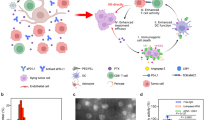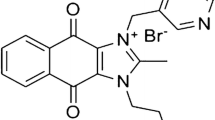Abstract
A new drug delivery approach, apoptotic-induced drug delivery (AIDD), is presented that is based on apoptosis as a mechanism to trigger delivery of drugs from carrier cells. It was investigated whether apoptotic drug-loaded carrier cells could deliver drugs to tumour cells by various mechanisms, including drug release through a more permeable apoptotic cell membrane, and by phagocytosis of drug-loaded apoptotic cells by tumour cells. The feasibility of this novel concept was evaluated in an in vitro carrier cell model that consisted of S49 mouse lymphoma cells that apoptose upon exposure to dexamethasone (DX). Membrane permeability was evaluated by measurement of release of a fluorescent dye (calcein-AM, C-AM) from C-AM-loaded S49 cells. Phagocytotsis of fluorescent PKH-26-labeled S49 cells was determined in co-culture studies with rat glioma (RG-2) cells using fluorescence microscopy and flow cytometry. Cytotoxicity of RG-2 cells due to temozolomide (TMZ)-loaded S49 cells was evaluated by a colony formation assay following co-culture of these cells for up to 8h. Calcein release from S49 cells was enhanced by approximately 30% at 48h following treatment with DX compared to control S49 cells. Based on both flow cytometric and microscopic analyses, RG2 phagocytized apoptotic S49 cells to a four- to sevenfold greater extent than control S49 cells at co-incubation times from 4–48h. The TMZ-loaded apoptotic S49 cells caused the largest degree of toxicity, about 50% cell kill, whereas TMZ-loaded control S49 caused 30% cell kill. The preliminary data suggest that AIDD should be further explored.
Similar content being viewed by others
References
Juliano RL. Drug Delivery Systems. New York, NY (USA): Oxford University Press, 1980.
Ma J, Verweij J, Kolker HJ, van Ingen HE, Stoter G, Schellens JHM. Pharmacokinetic-dynamic relationship of cisplatin in vitro: simulation of an iv bolus and 20 h infusion. Br J Cancer 1994; 69: 858–862.
Thomas N, Bell PA. Glucocorticoid-induced cell-size changes and nuclear fragility in rat thymocytes. Mol Cell Endocrinol 1981; 22: 71.
Fadok VA, Voelker DR, Campbell PA, Cohen JJ, Bratton DL, Henson PM. Exposure of phosphatidylserine on the surface of apoptotic lymphocytes triggers specific recognition and removal by macrophages. J Immunol 1992; 148: 2207–2216.
Bischof JC, Padanilam J, Holmes WH, et al. Dynamics of cell membrane permeability changes at supraphysiological temperatures. Biophys J 1995; 68: 2608–2614.
Lichtenfels R, Biddison WE, Schultz H, Vogt AB, Martin R. CARE-LASS (calecin-release assay), an improved fluorescence-based test system to measure cytotoxic T lymphocyte activity. J Immunol Meth 1994; 172: 227–239.
Baxter JD, Harris AW, Tomkins GM, Cohn M. Glucocorticoid receptors in lymphoma cells in culture: Relationship to glucocorticoid killing activity. Science 1971; 171: 189–191.
Wyllie AH. Glucocorticoid-induced thymocyte apoptosis is associated with endogenous nuclease activation. Nature 1980; 284: 555–556.
Steller H. Mechanisms and genes of cellular suicide. Science 195; 267: 1445–1456.
Colombo BM, Benedetti S, Ottolenghi S, et al. The ‘bystander effect’: association of U-87 cell death with ganciclovir-mediated apoptosis of nearby cells and lack of effect in athymic mice. Human Gene Ther 1995; 6: 763–772.
Freeman SM, Abboud CN, Whartenby KA, et al. The ‘bystander effect’: Tumor regression when a fraction of the tumor mass is genetically modified. Cancer Res 1993; 53: 5274–5283.
Hamel W, Magnelli L, Chiarugi VP, Israel MA. Herpes simplex virus thymidine kinase/ganciclovirmediated apoptotic death of bystander cells. Cancer Res 1996; 56: 2697–2702.
Newlands ES, Blackledge GRP, Slack JA, et al. Phase I trial of temozolomide. Br J Cancer 1992; 65: 287–291.
Hwu P, Yang JC, Cowherd R, et al. In vivo antitumor activity of T cells redirected with chimeric antibody/Tcell receptor genes. Cancer Res 1995; 55: 3369–3373.
Lau B, Indurti RR, Couraud P-O, Goldstein GW, Laterra J. Endothelial cell implantation and survival within experimental gliomas. Proc Natl Acad Sci 1994; 91: 9695–9699.
Ojeifo JO, Forough R, Paik S, Maciag T, Zwiebel JA. Angiogenesis-directed implantation of genetically modified endothelial cells in mice. Cancer Res 1995; 55: 2240–2244.
Plate KH, Breier G, Weich HA, Risau W. Vascular endothelial growth factor is a potential tumor angiogenesis factor in human gliomas in vivo. Nature 1992; 359: 845–848.
Rights and permissions
About this article
Cite this article
Ma, J., Gallo, J.M. Delivery of cytotoxic drugs from carrier cells to tumour cells by apoptosis. Apoptosis 3, 195–202 (1998). https://doi.org/10.1023/A:1009603023214
Issue Date:
DOI: https://doi.org/10.1023/A:1009603023214




